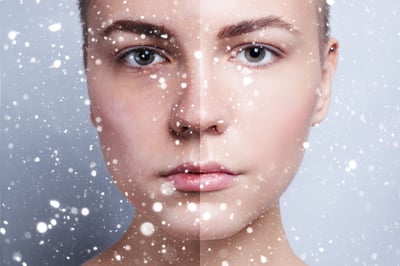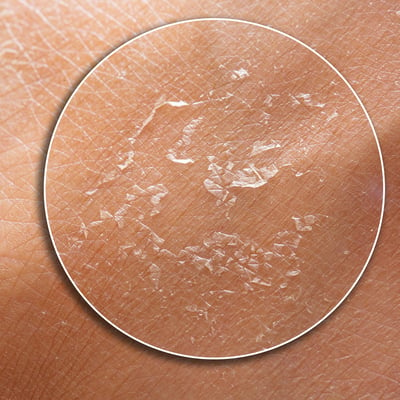
Let’s face it: A psoriasis outbreak can rear its ugly head (and itchy scales) any time of year. But as the temperature drops, some patients see even more of the telltale red or silver patches, and have no idea why,or what to do about them.
If you’re tired of dreading fall and winter because of the havoc it will wreak on your elbows, knees, and scalp, you owe it to yourself to find out what makes psoriasis worse in cooler weather, and how to stop it.
Psoriasis 101: What causes flare-ups any time of year?
To understand what causes psoriasis outbreaks, it helps to know how normal skin works. About every 28-30 days, a normal skin cell matures and falls off the body’s surface as your body produces newer skin cells. For patients with psoriasis, that process happens too quickly: Their skin cells mature in just three to four days and, instead of falling off to make room for new cells, they pile up and form scaly lesions.
This condition is a deficiency of the immune system, so outbreaks correlate with the body’s healing process. Lesions might pop up as a skin injury is trying to heal, or after an infection such as strep throat. Patients can also experience flare-ups during times of psychological stress since hormones are released to activate the immune system, which increases inflammation and speeds up cell production.
Why colder months make typical psoriasis triggers worse
Psoriasis tends to flare up in the fall or winter for several reasons having to do with the immune system:
More frequent infections. In fall and especially winter, upper respiratory infections, influenza and strep throat run rampant—which throws the immune system into overdrive. The more often a psoriasis patient gets sick, the more likely they are to have an outbreak.
Seasonal depression. It’s no secret that dark, cold, dreary weather can make us feel bad. Unfortunately, that sadness during fall and winter affects some worse than others, causing depression and anxiety that can last for months (a diagnosis called Seasonal Affective Disorder). According to a study published in the Journal of the American Academy of Dermatology, when going through a period of depression, patients with psoriasis tend to experience an inflammatory response in their skin. Psychological stress releases cortisol, and elevated cortisol levels impairs skin barrier function, leading to psoriasis breakouts.
Increased alcohol consumption. According to researchers at the University of Pittsburgh Division of Gastroenterology, alcohol consumption increases as temperature and sunlight hours drop. One major reason is that cold temperatures and lack of sunlight trigger sadness, and people turn to alcohol to cope with depression; but the holiday season can also lead to higher alcohol intake as people attend family gatherings and holiday parties. For those with psoriasis, alcohol use can cause lesions since it dries out the skin and hinders the immune system.
Goodbye sunshine: how darker days and lower temps contribute to outbreaks
Researchers have also found that the UV rays in sunlight slow skin cell production, resulting in fewer piled-up scales. That’s why many psoriasis patients don’t suffer as much throughout summer but have more outbreaks as they gravitate indoors in fall and winter (or cover up skin with warmer clothes). A 2021 study conducted at Xiangya Hospital, Central South University in China showed that patients who had occupations with more sunlight exposure during colder months (such as those in agriculture and construction) had fewer bouts of seasonal aggravation, while those who worked inside were affected more. In addition, they concluded that shorter days in fall and winter mean there’s not as much time to absorb sunlight.
Colder months also lack the humidity that’s present in late spring and summer. Not only is the outdoor air dry, but running the furnace in our homes dries out the indoor air. When the atmosphere lacks moisture, skin becomes parched. For psoriasis sufferers, dry skin makes the itching and irritation even worse. A survey analyzing how winter affected psoriasis patients across the globe showed that more people in the Northern Hemisphere (the United States, Canada, the United Kingdom and Ireland) than in the Southern Hemisphere (Australia and New Zealand) suffered flare-ups. They concluded that lower temperatures triggered physiological changes such as dry skin, impaired skin blood vessel function, and slower recovery after barrier damage.
How to beat cool-weather flare-ups
While there is no cure for psoriasis, there are ways to reduce its effects, particularly in fall and winter:
Hydrate. Dry skin can be a big trigger, so staying hydrated can help. Not only is it important to use moisturizing lotions and creams (ask your dermatologist for recommendations); it’s also crucial to drink plenty of water and eat hydrating foods such as vitamin E rich foods (like leafy green vegetables and whole grains) and omega-3 fatty acid-rich foods (such as fish, nuts and seeds). You can also use a humidifier in your home to add moisture to the air.
Catch some rays. Now is the perfect time to jetset to Jamaica or another sunny place since the lack of UVR exposure in autumn and winter triggers psoriasis. But if a tropical vacation isn’t possible, using light therapy or “phototherapy” with UVR can help. The machines are available at dermatologists’ offices and can also be purchased for at-home use, so ask your doctor which is best for your particular skin condition.
Stay healthy. Washing your hands often and staying away from people who are ill is the best way to avoid illness. If you do get sick with an infection, it’s important to see a doctor for an antibiotic as soon as possible to give your immune system a break. Some patients with recurring strep throat experience relief after having their tonsils removed, so it may be worth it to talk to your doctor to avoid future infections.
Find joy. Because psychological stress can worsen psoriasis symptoms, you may be able to find relief by doing what makes you happy. Laugh with friends; relax with a massage; exercise to release endorphins that relieve stress. If you are affected by SAD, consider seeing a therapistwho can offer techniques for dealing with depression. In the last decade, the association between mental health and psoriatic disease has strengthened significantly, and your dermatologist will be happy to refer you to a psychiatrist they trust.
Want more advice on how to minimize psoriasis triggers? Our physicians are here to help.
Life with psoriasis can feel very lonely, but at Forefront, our patients are never alone. As a team of physicians who went into the skincare industry to help people just like you, we strive to come up with solutions to make patients feel better both physically and emotionally. Schedule a consultation with a doctor near you today to get started. We can’t wait to meet you!





